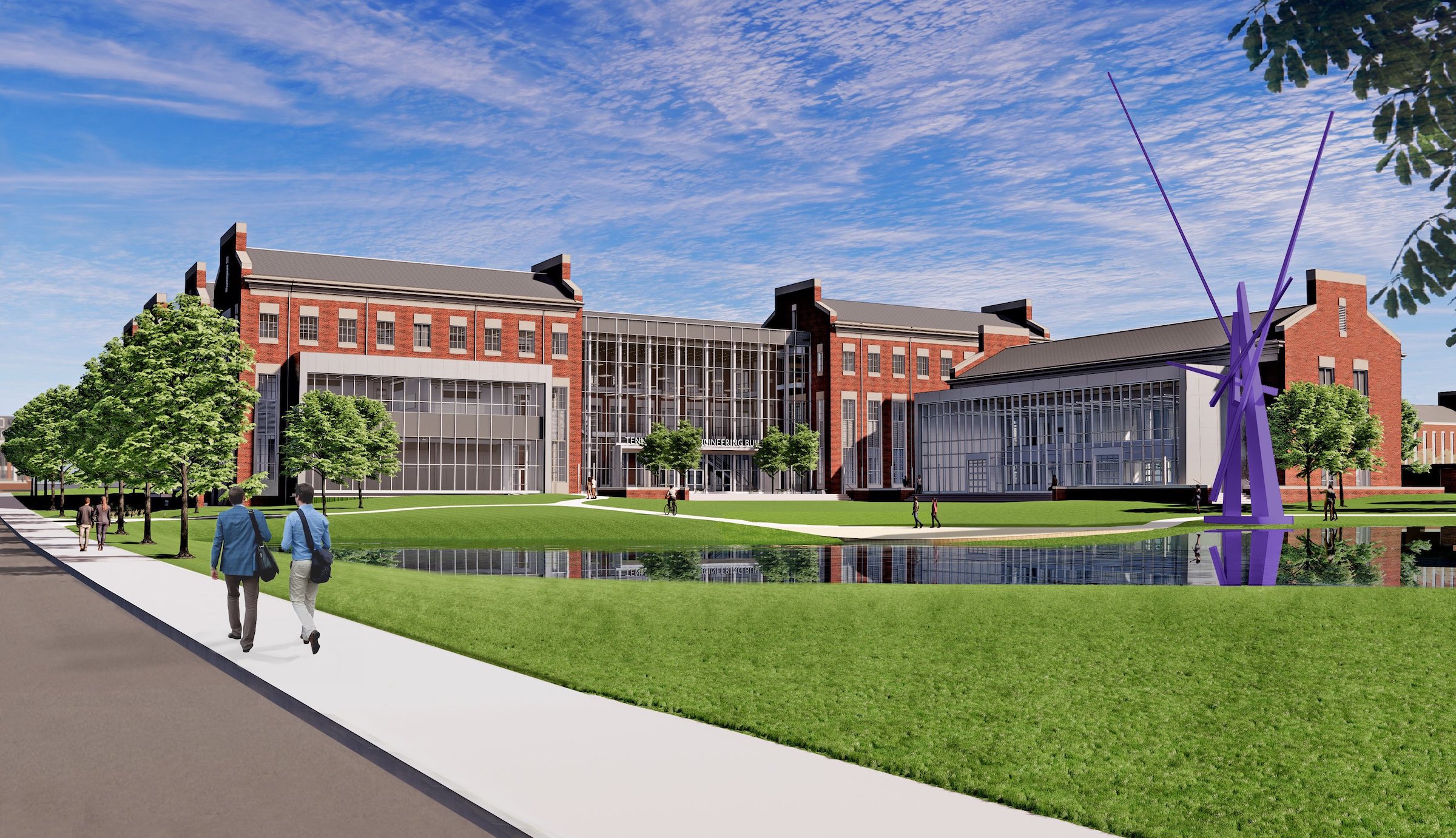News
Tennessee Tech gets its 'Wings' with 70-foot sculpture from acclaimed artist with state ties

Artist’s rendering of the new sculpture by the late John Henry slated for installation
outside Tech’s Ashraf Islam Engineering Building later this spring.
The campus of Tennessee Tech University will get an added burst of color and creative
inspiration with the installation of a monumental sculpture outside its soon-to-be-completed
Ashraf Islam Engineering Building.
The towering, nearly 70-foot steel structure is adorned in Tech’s signature shade
of purple and titled “Wings,” for its two outstretched beams. Weighing more than 12
tons, it was designed by famed sculptor John Henry and generously paid for by the
late Millard and JJ Oakley.
University administrators say the addition to campus is particularly meaningful, not
only for Henry’s Tennessee connections and worldwide acclaim, but also considering
his recent passing.
Henry died in November 2022 at the age of 79, having recently completed the designs
for Tech’s sculpture. He previously spent more than two decades in Chattanooga, where
he co-founded the Sculpture Fields at Montague Park, a world-class outdoor sculpture
garden and museum.
It was there that Tech leaders including President Phil Oldham and Board of Trustees
Chair Trudy Harper became acquainted with Henry’s artistry.
“I first met John and visited his studio while living in Chattanooga about 15 years
ago,” said President Oldham. “His art was impressive, and he had already established
a worldwide reputation for his work.”
In Harper’s case, she developed a close friendship with Henry and his wife, Pamela,
and was so moved by his work that she ended up purchasing two pieces for her home.
When it came time to consider a statement art piece to welcome visitors to the new
Ashraf Islam Engineering Building, President Oldham and Harper knew just the sculptor
to call.
“The years go by and I’m talking to President Oldham one day about the new engineering
building, which had not yet broken ground. I said I wanted us to be intentional about
investing in beautiful art for the building. He agreed and said ‘I have an artist
that I really like. Have you heard of John Henry?’” Harper recalled. “I said ‘not
only do I know John Henry, but he will be at my house for dinner next week and I own
two of his pieces!’ That was a fun way that everything collided.”
Oldham adds that the support of Millard and JJ Oakley, pillars of the Upper Cumberland
and longtime supporters of the university who both passed away within the last two
years, was “essential” to bringing the sculpture to campus.
“It would not have been possible without them,” Oldham said.
Harper, who holds two electrical engineering degrees from Tech, noted that Henry’s
unique approach to sculpture is well-suited for the university’s new engineering building.
“John was not a classically trained engineer, but he engineered his sculptures unlike
anything else I’ve ever seen before,” Harper explained. “I think our engineering students
will take away a curiosity for how he manages to create an illusion that is so weighty,
but also has a sense of airiness – almost like it is not being supported at all. I
hope that will be an inspiration.”
Henry was the sculptor behind iconic works such as the 101-foot-tall “Tatlin Sentinel”
in Dallas, Texas’s Hall Arts District, and the 89-foot-tall “Songbird” in Seattle,
Washington. He was also the recipient of the International Sculpture Center’s 2023
Lifetime Achievement Award. While he passed away before he could formally accept the
award, he lived to learn of his selection.
“He was larger than life, both as an artist and as a person,” said Katherine Henry,
John Henry's daughter and former studio manager. “He filled the room. He had an incredible
sense of humor and a very charismatic personality. He never met a stranger.”
The younger Henry credits Tennessee for providing her father a welcoming home and
supportive community over his many years in Chattanooga.
“When he moved to Tennessee, he felt very comfortable there,” Katherine added. “He
had a wonderful studio just on the other side of the railroad tracks from Sculpture
Fields in Chattanooga … He felt supported and he made really good friends in Tennessee.”
Katherine adds that the Tech sculpture was among her father’s last completed works
– one of only four pieces in his studio when he passed away. Following his death,
Henry’s wife, Pamela, gave the Tech sculpture a new working title on the studio’s
internal communications: “best for last.”
“It is important for the development of campus, as we strive to inspire future generations
of students, to have public art that lifts the spirit and challenges us all to think
beyond the norm,” concluded President Oldham. “Having one of the last pieces created
by an artist of John Henry’s caliber is a great opportunity.”

